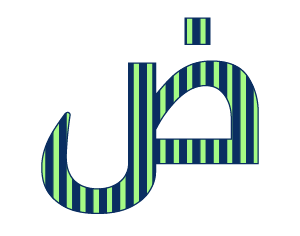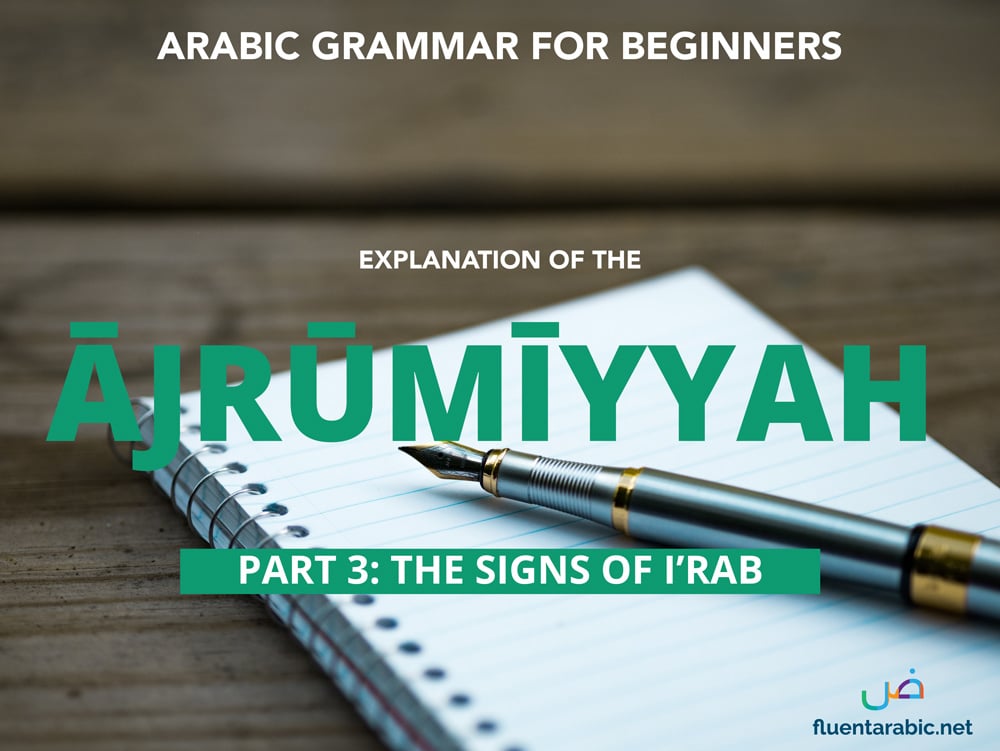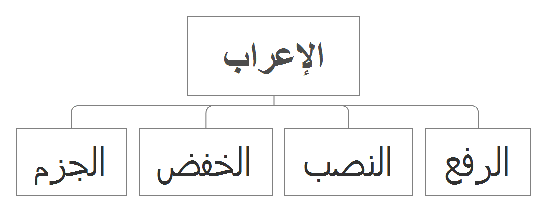Chapter 3: Knowing the Signs of I’rab
In the previous chapter, we discussed the I’rab, Mabni and Mu’rab. In this chapter, we discuss the indicators and signs of the I’rab.
What indicates if a word is in the state of Raf’, Nasb or Khafdh or Jazm? These states are not always indicated by dhamma, fatha, kasra and sukun. In some cases, they are indicated by letters. In some cases, Khafdh is indicated by fatha instead of kasra. This is what we learn in this chapter.
Ibn Ajrum actually explains this lesson with two different methodologies. First, he goes through each sign, one by one, and mentions all the cases they can represent, and in which scenarios. Then, under the next section (Mu’rabat) he goes through each grammatical element and mentions the indicators they use.
However, we will use a methodology used by some Shuyukh that I find much simpler. We will explain the cases in which the grammatical state is indicated by other than its default indicator – dhamma for Raf’, fatha for Nasb, kasra for Khafdh and sukun for Jazm. Also, the information is presented in tables which are easy for you to understand, insha’Allah.
The default indicators of I’rab are: dhamma for Raf’, fatha for Nasb, kasra for Khafdh and sukun for Jazm.
First, let’s look at the Matn,
Matn (Text of Al-Ājrūmīyyah)
بَابُ مَعْرِفَةِ عَلاَمَاتِ الإِعْرَابِ
لِلرَّفْعِ أَرْبَعُ عَلَامَاتٍ الضَمَّةُ وَالوَاوُ وَالأَلِفُ وَالنُّونُ.
فَأَمَّا الضَّمَّةُ فَتَكُونُ عَلَامَةً لِلرَّفْعِ فِي أَرْبَعَةِ مَوَاضِعَ : فِي الِاسْمِ المُفْرَدِ وَجَمْعِ التَّكْسِيرِ وَجَمْعِ المُؤَنَّثِ السَّالِمِ وَالفِعْلِ المُضَارِعِ الَّذِي لَمْ يَتَّصِلْ بِآخِرِهِ شَيْءٌ.
وَأَمَّا الوَاوُ فَتَكُونُ عَلَاَمَةً لِلرَّفْعِ فِي مَوْضِعَيْنِ: فِي جَمْعِ الْمُذَكَّرِ السَّالِمِ وَفِي الأَسْمَاءِ الْخَمْسَةِ وَهِي: أَبُوكَ وَأَخُوكَ وَحَمُوكَ وَفُوكَ وَذُو مَالٍ.
وَأَمَّا الأَلِفُ فَتَكُونُ عَلَامَةً لِلرَّفْعِ فِي تَثْنِيَةِ الأَسْمَاءِ خَاصَّةً.
وَأَمَّا النُّونُ فَتَكُونُ عَلَامَةً لِلرَّفْعِ فِي الفِعْلِ الْمُضَارِعِ إِذَا اِتَّصَلَ بِهِ ضَمِيرُ التَّثْنِيَةِ أَوْ ضَمِيرُ جَمْعٍ أَوْ ضَمِيرُ الْمُؤَنَّثَةِ الْمُخَاطَبَةِ.
Translation:
“For the state of Raf’ there are four indicators: dhamma, waw, alif, and nun.
As for the Damma, it becomes an indicator of Raf’ in four instances: 1) Singular Noun 2) Broken Plural 3) Sound Feminine Plural and 4) Present Tense Verb with nothing attached to its end (like the Feminine Nun or the Nun of confirmation)
As for the Waw, it becomes an indicator of Raf’ in two cases: 1)The Sound Masculine Plural and 2) The Five Names, and they are: Abooka, Akhooka, Khamooka, Fooka and Dhoo Malin.
As for the alif, it is an indicator of Raf’ only for the dual form of nouns.
As for the Nun, it is an indicator of Raf’ for the present tense verb when it is connected to the dual or plural pronoun, or if an attached pronoun is used to address a female in the second person.
وَلِلنَّصْبِ خَمْسُ عَلَاَمَاتٍ: الْفَتْحَةُ وَالأَلِفُ وَالكَسْرَةُ واليَاءُ وَحَذْفُ النُّونِ.
فَأَمَّا الْفَتْحَةُ فَتَكُونُ عَلَاَمَةً لِلنَّصْبِ فِي ثَلَاثَةِ مَوَاضِعَ: فِي الاِسْمِ الْمُفْرَدِ وَجَمْعِ التَّكْسيرِ وَالْفِعْلِ الْمُضَارِعِ إِذَا دَخَلَ عَلَيْهِ نَاصِبٌ وَلَمْ يَتَّصِلْ بآخِرِهِ شَيْءٌ.
وَأَمَّا الْأَلِفُ فَتَكُونُ عَلَاَمَةً لِلنَّصْبِ فِي الأَسْمَاءِ الْخَمْسَةِ نَحْوَ: رَأَيْتُ أَبَاكَ وَأَخَاكَ وَمَا أشْبَهَ ذَلِكَ.
وَأَمَّا الكَسْرَةُ فَتَكُونُ عَلَامَةً لِلنَّصْبِ فِي جَمْعِ المُؤَنَّثِ السَّالِمِ.
وَأَمَّا اليَاءُ فَتَكُونُ عَلَامَةً لِلنَّصْبِ فِي التَّثْنِيَةِ وَالجَمْعِ.
وَأَمَّا حَذَفُ النُّونِ فَيَكُونُ عَلَاَمَةً لِلنَّصْبِ فِي الْأَفْعَالِ الْخَمْسَةِ الَّتِي رَفْعُهَا بِثَبَاتِ النُّونِ.
And (the state of) Nasb has five indicators: al-fatha, al-kasra, al-ya, and the removal of the letter Nun.
As for the Fatha, it becomes an indicator of Nasb in three cases: 1)The Singular Noun 2)The Broken Plural 3)The Present Tense Verb if a particle of Nasb is added to it, and there is nothing attached to its end.
As for the Alif, it becomes an indicator of Nasb in the five nouns: like this:
(رأيت أباك وأخاك)
And in what resembles this.
As for the Kasra, it becomes an indicator of Nasb for the Sound Feminine Plural.
As for the Ya, it becomes an indicator of Nasb, for the dual and plural forms of the noun.
As for the removal of Nun, it becomes an indicator of Nasb in the Five Verbs, in which case the state of Raf’ is indicated by the affirmation of the Nun.
.ولِلْخَفْضِ ثَلَاثُ عَلَامَاتٍ: الكَسْرَةُ واليَاءُ وَالفَتْحَةُ
.فَأَمَّا الْكَسْرَةُ فَتَكُونُ عَلَامَةً لِلْخَفْضِ فِي ثَلَاثَةِ مَوَاضِعَ: فِي الاِسْمِ الْمُفْرَدِ الْمُنْصَرِفِ وَجَمْعِ التَّكْسِيرِ المُنْصَرِفِ وَجَمْعِ الْمُؤَنَّثِ السَّالِمِ
.وَأَمَّا اليَاءُ فَتَكُونُ عَلَاَمَةً لِلْخَفْضِ فِي ثَلَاثَةِ مَوَاضِعَ: فِي الْأَسْمَاءِ الْخُمْسَةِ وَفِي التَّثْنِيَةِ وَالْجَمْعِ .وَأَمَّا الْفَتْحَةُ فَتَكُونُ عَلَامَةً لِلْخَفْضِ فِي الاِسْمِ الَّذِي لَا يَنْصَرِفُ
And the (state of) Khafdh has three indicators: Kasra, Ya and Fatha.
As for the Kasra, it becomes an indicator of Khafdh in three cases: 1) The singular noun which is munsaraf (not mamnu’ min as-sarf) 2) The Broken Plural which is munsaraf (not mamnu’ min as-sarf) 3) The Sound Feminine Plurals.
As for the Ya, it becomes an indicator of Khafdh in three cases: 1)The Five Nouns 2)The Dual Form 3)The Plural Form
As for the Fatha, it becomes an indicator of Khafdh for the nouns who are fixed (mamnu’ min as-sarf)
.وَلِلْجَزْمِ عَلَامَتَانِ: السُّكُونُ وَالْحَذْفُ
.فَأَمَّا السُّكُونَ فَيَكُونُ عَلَاَمَةً لِلْجَزْمِ فِي الفِعْلِ المُضَارِعِ الصَّحِيحِ الْآخِرِ
.وَأَمَّا الْحَذْفُ فَيَكُونُ عَلَاَمَةً لِلْجَزْمِ فِي الفِعْلِ الْمُضَارِعِ الْمُعْتَلِّ الآخِرِ وَفِي الأَفْعَالِ الْخَمْسَةِ الَّتِي رَفْعُهَا بِثَبَاتِ النُّونِ
And for the (state of) Jazm, there are two indicators: The Sukun and Removal,
As for the Sukun, it becomes an indicator for Jazm in the present tense verbs which end with a sound-letter (other than ي، و،ا).
As for Removal, it is an indicator of Jazm for present tense verbs ending with a weak letter ( ي، و،ا) and also for the five verbs in whose case the state of Raf’ is indicated by the affirmation of Nun.”
As we have already seen, in Arabic, words can take 4 grammatical states – Raf’, Nasb, Khafdh and Jazm. This chapter and the one after this deal with the signs that tell us which state the word is in. The chapter makes this look slightly complicated, but we are going to stick to a simplified explanation, that you can grasp easily, insha’Allah.
The Cases In Which The I’rab Is Indicated By Other Than The Default Indicator
In the vast majority of cases, Raf’ is indicated by dhamma ( ُ ), Nasb is indicated by fatha ( َ ), Khafdh or Jarr by kasra ( ِ ) and finally Jazm by sukun ( ْ ).
However, there are other cases where the grammatical state is indicated by other indicators. We will go through these cases one by one.
There are seven basic cases where the I’rab is indicated by other than the default indicator.
1.المثنى
In the dual form the states are denoted by alif and ya as shown:
| الجزم | الخفض | النصب | الرفع | |
|---|---|---|---|---|
| الياء | الياء | الألف | المثنى |
جاء الطالبانِ إلى المدرسةِ (رفع)
رأيتُ الطالبَينِ في المدرسةِ (نصب)
حَتَّى أَبْلُغَ مَجْمَعَ الْبَحْرَيْنِ (خفض)
2. جمع المذكر السالم
It is the plural made by attaching the waw and nun or ya and nun to the male noun.
The I’rab is indicated as follows:
| الجزم | الخفض | النصب | الرفع | |
|---|---|---|---|---|
| الياء | الياء | الواو | جمع المذكر السالم |
وَالْمُؤْمِنُونَ وَالْمُؤْمِنَاتُ بَعْضُهُمْ أَوْلِيَاءُ بَعْضٍ (رفع)
وَكَذَلِكَ نُنجِي الْمُؤْمِنِينَ (نصب)
مَرَرتُ بِمُسْلِمِينَ (خفض)
3. جمع المؤنث السالم
The plural made by adding alif before the final ‘ta’ in a feminine noun.
The indicators are:
| الجزم | الخفض | النصب | الرفع | |
|---|---|---|---|---|
| الكسرة | الكسرة | الضمة | جمع المؤنث السالم |
إِذَا جَاءَكَ الْمُؤْمِنَاتُ (رفع)
خلقَ اللهُ السَّمواتِ (نصب)
وَقُل لِّلْمُؤْمِنَاتِ يَغْضُضْنَ مِنْ أَبْصَارِهِنَّ (خفض)
Note here that, for Nasb, instead of fatha, kasra is used.
4.الأسماء الخمسة
These nouns are:
أب ، أخ ، حم ، فم ، ذو
When these nouns are attached with other nouns, they are used as follows:
أبوك ، أخوك ، حموك ، فوك، ذو علم (حالة الرفع)
أباك ، أخاك ، حماك ، فاك، ذا علم (حالة النصب)
أبيك ، أخيك ، حميك ، فيك، ذي علم (حالة الخفض)
The States are indicated as follows:
| الجزم | الخفض | النصب | الرفع | |
|---|---|---|---|---|
| الياء | الألف | الواو | الأسماء الخمسة |
أبو فهد صاحبُ والدي
رأيتُ أباكَ
رأيتُ صَديقَ أبيكَ
5. ممنوع من الصرف
Nouns which don’t accept the tanween or the kasrah. We deal with the details of these nouns later. But the rule pertaining to them is that both Nasb and Khafdh are indicated by fatha.
| الجزم | الخفض | النصب | الرفع | |
|---|---|---|---|---|
| الفتحة | الفتحة | الضمة | الممنوع من الصرف |
رجعَ أحمدُ إلى بيتهِ
رأيتُ أحمدَ في المكتبةِ
سلَّمْتُ على أحمدَ صباحًا
6. المضارع المعتل الآخر
These are verbs ending with one of the letters of illa: alif, waw or ya: as in:
يخشى، يدعو، يقضي
In this case, the Jazm is indicated by hiding the final letter (the letter of illa).
| الجزم | الخفض | النصب | الرفع | |
|---|---|---|---|---|
| حذف حرف العلة | - | الفتحة | الضمة | المضارع المعتل الآخر |
لَمْ يَخْشَ إِلاَّ اللّهَ
محمدٌ يهدي إلى الحق (علامة رفعها الضمة المقدرة منعها من ظهروها الثقل)
محمدٌ لن يدعُوَ إلا ريَهُ
محمدٌ لم يدعُ إلا ربَهُ
7. الأفعال الخمسة
These are the nouns which have alif and noun, waw and noun, or ya and noun attached to them.
الأفعال الخمسة هي :
1- تذهبان – أنتما
2- تذهبين – أنتِ
3- يذهبون – هم
4- تذهبون – أنتم
5- يذهبان – هما
In this case, both Nasb and Jazm are indicated by hiding the nun. There is no Khafdh as it is a present tense verb.
| الجزم | الخفض | النصب | الرفع | |
|---|---|---|---|---|
| حذف النون | - | خذف النون | ثبوت النون | الأفعال الخمسة |
أنتم تأكلون
وَأَنْ تَصُومُوا خَيْرٌ لَكُمْ
لن تأكلوا
If you study these seven cases thoroughly, you will be able to master the signs of I’rab inshaAllah. To recap the chapter here is the complete list of I’rab indicators: (revise this table until you master it thoroughly)
| الجزم | الخفض | النصب | الرفع | |
|---|---|---|---|---|
| الكسرة | الفتحة | الضمة | جمع التكسير | |
| حذف النون | - | خذف النون | ثبوت النون | الأفعال الخمسة |
| السكون | - | الفتحة | الضمة | المضارع الصحيح الآخر |
| حذف النون | - | الفتحة | الضمة | المضارع المعتل الآخر |
| الفتحة | الفتحة | الضمة | الممنوع من الصرف | |
| الياء | الألف | الواو | الأسماء الخمسة | |
| الكسرة | الكسرة | الضمة | جمع المؤنث السالم | |
| الياء | الياء | الواو | جمع المذكر السالم | |
| الياء | الياء | الألف | المثنى | |
| الكسرة | الفتحة | الضمة | المفرد |
Matn (Text of Al-Ājrūmīyyah)
فَصْلٌ : المُعْرَبَاتُ قِسْمَانِ: قِسْمٌ يُعْرَبُ بِالحَرَكَاتِ، وَقِسْمٌ يُعْرَبُ بِالحُرُوفِ.
فَالَّذِي يُعْرَبُ بِالحَرَكَاتِ أَرْبَعَةُ أَنْوَاعٍ: الاِسْمُ المُفْرَدُ، وَجَمْعُ التَّكْسِيرِ، وَجَمْعُ المُؤَنَّثِ السَْالِمِ، وَالفِعْلِ المُضَارِعُ الَّذِي لَمْ يَتَّصِلْ بِآخِرِهِ شَيْءٌ.
وَكُلُّهَا تُرْفَعُ بِالضَمَّةِ، وَتُنْصَبُ بِالفَتْحَةِ، وَتُخْفَضُ بِالكَسْرَةِ، وَتُجْزَمُ بِالسُّكُونِ، وَخَرَجَ عَنْ ذَلِكَ ثَلَاثَةُ أَشْيَاءٍ: جَمْعُ المُؤَنَّثِ السَْالِمِ يُنْصَبُ بِالكَسْرَةِ، وَالاِسّمُ الَّذِي لَا يَنْصَرِفُ يُخْفَضُ بِالفَتْحَةٍ، وَالفِعْلُ المُضَارِعُ المُعْتَلُ الآخِرِ يُجْزَمُ بِحَذْفِ آخِرِهِ.
وَالَّذِي يُعْرِبُ بِالحُروفِ أَرْبَعَةُ أَنْوَاعٍ: التَّثْنِيَةُ، وَجَمَعُ المُذَكَّرِ السَّالِمِ، وَالأَسْمَاءِ الخَمْسَةِ، وَالأَفْعَالُ الخَمْسَةُ، وَهِي: يَفْعَلَانِ، وَتَفْعَلَانِ، وَيَفْعَلُونَ، وَتَفْعَلُونَ، وَتَفْعَلِينَ.
فَأَمَّا التَّثْنِيَةُ فَتُرْفَعُ بِالأَلِفِ، وَتُنْصَبُ وَتُخْفَضُ بِاليَاءِ.
وَأَمَّاَ جَمْعُ المُذَكَّرِ السَّالِمِ فَيُرْفَعُ بِالوَاوِ، وَيُنْصَبُ وَيُخْفَضُ بِاليَاءِ.
وَأَمَّا الْأَسْمَاءُ الخَمْسَةِ فَتُرْفَعُ بِالوَاوِ، وَتُنْصَبُ بِالأَلِفِ، وَتُخْفَضُ بِاليَاءِ.
وَأَمَّا الأَفْعَالُ الخَمْسَةُ فَتُرْفَعُ بِالنُّونِ وَتُنْصَبُ وَتُجْزَمُ بِحَذْفِهَا.
Translation: Section: Inflected Words:
Inflected words are two categories: 1)Those that are inflected with vowel markings 2)Those that are inflected with letters. As for those that are inflected with vowel markings, they are four types: 1) The Singular Noun, 2) The Broken Plural 3) The Sound Feminine Plural 4) The Present Tense Verb ending with a sound letter and nothing attached to its end. All of these are indicated in the Raf’ state by the Dhamma, in Nasb state by the Fatha, the Khafdh state by the Kasra and the Jazm state by the Sukun. There are three exceptions: 1) The Sound Feminine Plural – which in Nasb has Kasra 2) The Noun that is not Munsaraf (Mamnu’ min as-sarf) – which in Khafdh has Fatha 3) The Present Tense Verb that ends with a weak letter ( ي، و،ا) – which in Jazm has the final letter removed.As for the words inflected with letters they are four types: 1)The dual 2) The Sound Masculine Plural 3) The Five Nouns 4) The Five Verbs:
يَفْعَلَانِ، وَتَفْعَلَانِ، وَيَفْعَلُونَ، وَتَفْعَلُونَ، وَتَفْعَلِينَ.
As for the dual, the state of Raf’ is indicated by al-Alif, and Nasb and Khafdh by Al-Ya. As for the Sound Masculine Plural, the state of Raf’ is indicated by al-Waw, Nasb and Khafdh by al-Ya. As for the five nouns, the state of Raf’ is indicated by al-Waw, Nasb with Al-Alif and Khafdh by Al-Ya. As for the five verbs, Raf’ is indicated by the (affirmation of) nun and Nasb by the omission of nun.
This section is the repetition of the same concept (indicators of I’rab), but here ibn Ajrum explains it in a different manner. I want you to treat this section as a revision for what we have learned previously. Go through the text and see if you can match it to what is given in the previous table.
[thrive_leads id=’2260′]
Next Lesson:
Previous Lesson:




